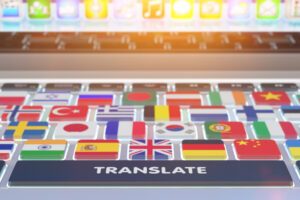Note: This blog post was originally written in Japanese for our Japanese website. We used our machine translation platform Translation Designer to translate it and post-edit the content in English. The original Japanese post can be found here.
In recent years, the accuracy of machine translation has improved remarkably. Because of this, some translation service businesses and translators worry that machine translation will replace them.
There is no doubt that the accuracy of machine translation has improved, but does that mean all of us will go out of business?
In this post, we would like to share our thoughts regarding this ongoing question.

Professional translation services won't go away
There you go — you have our answer! (But wait, this is not the end of our post.)
However, since technology is advancing day by day, please note that this is our view as of today. It is unlikely that translators will lose their jobs at this point and that professional translation demands will go away. What is more important is why we believe so.
We focused on three points: translation quality, expertise, and translation errors.
Translation quality
First of all, with the advent of AI-based neural machine translation (NMT) technology, the accuracy of machine translation has certainly improved overall compared to those that were statistics-based and rule-based. Nevertheless, it is clear that the deliverables are still inferior to that of professional translators.
For example, we often get the impression that machine translation results are quite good when checked sentence by sentence. Even so, it is common that the context is not taken into consideration before and after the sentence or as a whole document. Another common case is having inconsistency in the translated terms even though the original terms are the same.
In that respect, it is obvious that human translation or professional translation have higher quality than machine translation. Translators can take the context into consideration and maintain consistency in the terminology by working with computer-assisted translation (CAT) tools.

Expertise
When using machine translation for contents in highly specialized fields such as medical fields, the accuracy of machine translation cannot be said to be high. The difference is clear when you compare it to translations done by professional translators with expertise. Experts in the field will probably not be satisfied with the machine translation output.
But there is still room for improvement in this area. You can improve the accuracy by customizing your machine translation engine for field-specific or in-house use. There is a downside to customization though. Since a huge corpus is required to customize an engine, this can be a high hurdle even if you want to create your own custom engine for machine translation. Unless you're one of the tech giants, it's usually rare for a company to have such huge data on its own.
With that said, there are ways to make it happen. Don't worry! Although there are some specific usage conditions, Kawamura offers engine customization services for all companies. If you are interested, reach out to us for more information.

Translation errors
In machine translation, it is pretty common to have errors such as misinterpretations and missing translations without any reason. How each machine translation provider will improve these errors in the future is a hot topic. But at the moment, there is no option other than manual correction, that is, post-editing, as a countermeasure for this part. Of course, we can detect and process some errors mechanically, but depending on the type of error, correction by post-editing is inevitable.
Since we mentioned post-editing, let's sidetrack a bit here. If you're thinking about using machine translation and taking care of post-editing yourself for your future translation projects, you need to be a little careful. As said earlier, the accuracy of machine translation has improved. But because of that, ironically, people often overlook errors due to its fluent translation. For better or worse, this is one of the characteristics of NMT. So, it's better to keep this in mind when you do the post-editing work. Otherwise, you may fall into a pitfall unexpectedly.
By the way, Kawamura provides not only professional translation services but also machine translation with post-editing services. In case you don't have time to post-edit yourself or want it professionally done, we're happy to help you out. Feel free to contact us even if it's a potential project.
Going back to our original topic… the chance of getting translation errors is lower with human translation. In addition, professional translators try their best to prevent errors by utilizing quality assurance tools. Due to these factors, the workload on subsequent translation reviews is reduced, and it can be said that human translation is still superior.
So, are we good then?
With the above three points, we have stated that translators will not lose their jobs. Does that mean the future of professional translation service businesses are secured?
We believe that professional translation demands will not go away for the time being. However, as we wrote at the beginning of this post, this statement is based on the current situation. No one knows what the future holds for us. We can't avoid the fact that the accuracy of machine translation has definitely improved (as already mentioned many times). With more advancement in AI, a ridiculously high-performance machine translation technology that exceeds our imagination might appear in the near future. Hence we need to stay alert.
Have you noticed this post is titled "part 1"? Yes, this discussion continues a little more. In part 2, we will talk about how to use professional translation and machine translation services in different situations.
Machine translation with post-editing
Demand for machine translation with post-editing (MTPE) services is increasing more and more. With MTPE services, we make the best use of machine translation output to provide cost effective translations.
Machine translation is the fastest and the most low-cost solution, but without any editing work, its quality may be insufficient for your translation purposes. By adding the post-editing process, our linguists will edit the content and adjust the translations so that the quality is closer to what you're looking for.
Although, we must say that machine translation with post-editing is not suitable for all contents and documents. Yet centering around localization, marketing translation and mass media translation work pretty well with post-editing. With the evolution and development of machine translation engines, the skills required of post-editors are gradually changing as well. We definitely have to keep an eye on the trends in machine translation and post-editing.
Kawamura's translation services
Kawamura has been taking on machine translation with post-editing projects from early days. Our post-editing service is backed by the knowledge gained from numerous projects and our experienced post-editors. We have professional post-editors who we can rely on for delivering accurate Japanese translation. Not only that, we can also secure native-speaking post-editors for other Asian languages, European languages, and more.
Every year, we are getting more and more requests for post-editing services in many languages, not limited to just English and Japanese. Let us offer you various solutions for any kind of requests or issues you have. Feel free to contact us for a quote or any questions in general.
_CMYK_OL.png)

